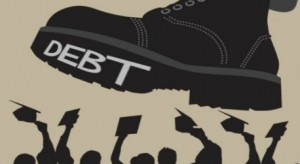In May 2017, the New York Times ran an in-depth article detailing the US household debt burden. At the time of writing, US household debt exceeded $12.73 trillion.
The major components of the data included the following:
- Housing-related debt component at 71.4%
- Student Loans – 10.6%
- Automobile Loans – 9.2%
- Credit Card Debt – 6.0%
- Other Debt – 2.9%
The important takeaways from the article relate to the debt level exceeding the household debt in Q3 2008, at the height of the global financial crisis. At that stage, total outstanding household debt was $12.68 trillion, and by January 2018, credit card debt exceeded $1 trillion. It appears that the US psyche is bent on excessive debt, and debt-fuelled growth. US GDP does not paint an accurate picture of the state of the economy, given that such a large component of expenditure is credit-related expenditure. Nonetheless, lines of credit are needed to finance big-ticket purchases such as real estate, automobiles, equipment, machinery and business ventures.
Without credit-fuelled growth, economic growth is impossible. Consumption expenditure in the US accounts for 70% of GDP, and much of that takes place with lines of credit. The biggest bugbears for credit-fuelled spending are mortgage debt, student loans, automobile loans and credit cards in that order. Of course, there is good and bad debt. Good debt is typically comprised of asset purchases and education, while bad debt relates to automobile expenditure and credit card debt. The question as to whether debt is a necessary evil is easily answered: it is.
How Best to Manage Debt?
There are many opinions on how debt should be managed. The easiest ways to manage debt include curtailing expenditure, living beneath your means, cutting back on unnecessary expenses, and delaying big-ticket purchases. Of course, once all these measures have been put into play, there is still outstanding debt to contend with. If this debt exists in the form of credit card debt, there are viable options to be had. These include many debt management options.
The undiscerning nature of debt means that anyone and everyone faces these financial challenges at any given time. From Hollywood A-list stars like Tyler Perry to the president of the United States, debt is a universal phenomenon. Effective debt management is essential in all instances. For anyone wanting to emerge from lower socioeconomic rungs and enter the middle-class, or the upper-class leagues, it’s important to take control of debt by adopting a hands-on approach to your finances. Debt consolidation is one of the most robust, effective, and powerful ways to eliminate high-interest debt repayments quickly and easily.
For starters, the concept of debt consolidation is best applied to existing debt before the debtor has defaulted on payments. If you have outstanding credit card debt at high interest rates (high APRs), it’s important to evaluate the best ways to reduce the monthly debt burden. By applying for a personal loan at a lower interest rate than the prevailing APR on the credit card debt, it is possible to repay all the outstanding credit card debt and eliminate the interest-related payments on that debt. Debt consolidation loans are affordable ways to reduce expenditure on the interest -related component of the loans. The cost savings can go towards paying down the principal, or a Rainy-Day fund.
The Time to Act Is Now.
Any delays in repaying high APR debt are to your detriment. Central banks around the world are currently undergoing monetary tightening, and adopting measures that are detrimental to people with high levels of debt. Every time the federal funds rate increases by 25-basis points, this adds a chunk of change onto your interest-related debt repayment every month. Much the same is true of outstanding variable mortgage interest rates, which also increases as the federal funds rate rises. It is best to lock in a low interest-rate loan as quickly as possible, since this guarantees that your repayments on outstanding debt will be capped for the duration of the payback period.
The best advice is to pay down high-interest debt as quickly as possible to improve one’s personal financial situation. Credit card debt is the #1 biggest culprit for eating into personal disposable incomes and the shrinking pay checks of US households. It’s difficult to meet your long-term financial objectives if you’re continually battling debt demons. Take one component of your debt at a time – student loans, personal loans, credit cards, mortgage debt, car loans etc., and get it paid off quickly. Consider that the typical US household has an estimated $46,697 in student loan debt, $27,669 in automobile debt, and $15,654 in credit card debt. These are untenable negative balances, and they only keep on growing every month.
from Young Upstarts http://ift.tt/2rD5oQB via website design phoenix

No comments:
Post a Comment